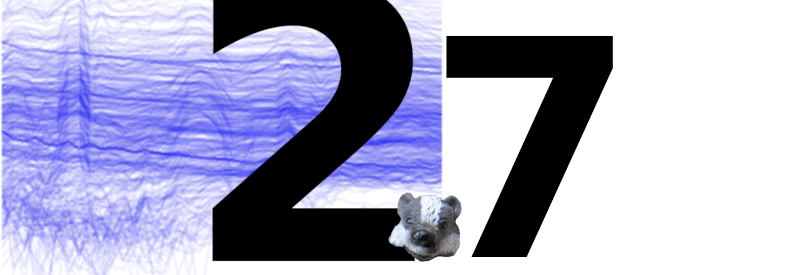
Last Friday, I have released Version 2.7 of GAVO's Virtual Observatory server package DaCHS. As is customary, I will give a brief overview of the more noteworthy changes in this blog post. This is probably only of interest to people running DaCHS-based data centres. What I discuss here is both a bit more verbose and a bit less extensive than what you find in the Changes file (when installed from package, you would read it by running /usr/share/doc/python3-gavo/changelog.gz).
The highlight in this release from my view are simple, numpy-like vector operations in ADQL. Regular readers of this blog will already have seen an example for their use. This is altogether a prototype, which is why what specification is there is only on the IVOA wiki. It is thus likely some details of the vector math will change until they make it into any sort of standard (I am hoping for ADQL 2.2). This should not keep you from trying it out and telling your users about it.
In that same vein, the FITS binary table grammar now copes with vectors, which makes it easier to populate tables that make these operations useful, and for the sort of large tables where the array magic has particularly much promise, it is now a lot simpler to feed array-valued columns with C boosters.
Other ADQL work includes the addition of proper, standards-compliant epoch propagation (i.e., “application of proper motion and radial velocity“) in the form of the ivo_epoch_prop and ivo_epoch_prop_pos user defined functions. Regrettably, this will not immediately work for you, as it builds on a feature in pgsphere that upstream has not merged yet; comments on that PR will certainly help make that happen. Of course, if you want, you can just build the pgsphere branch containing the new feature yourself. To make up for this complication, DaCHS will no longer advertise UDFs that will not work given the database extensions present – which will help me be a bit more liberal in letting in UDFs wrapping functionality not in Postgres' default distribution in the future.
If you run datalink services and have multiple items with the same semantics, you may be interested in using local_semantics in Datalink. The use case here is that clients like TOPCAT will remain on, say, light curves in a red filter when the user jumps between records rather than randomly switching between red and blue ones when both have #coderived semantics (Mark's proposal). If you have data of this kind: you can now pass a localSemantics parameter to the makeLink and makeLinkFromFile methods of datalink descriptors; what string you use is up to you, as long as it's the same between similar rows for different datasets.
I tend to forget that surprisingly many people actually do something with the ADQL form you get on DaCHS' web interface rather than use a TAP client. Well, a DaCHS operator complained about really sub-standard table headings in the HTML tables coming out of this service. Looking again, I had to admit he was right. So, TAP columns now have more meaningful table headings; in particular, if you write expressions, up to a certain length these expressions will be used as table headings. At least in this respect the ADQL form now has an advantage over using a proper client.
In case you have a processor doing astrometric calibration with astrometry.net (you probably don't because it would have been very hard to make that work on without a lot of hacks so far) – have another look at the documentation because I have had various reasons to change api.AnetHeaderProcessor's API in quite a number of ways. It's now a lot easier to use with astrometry.net and source-extractor as distributed by Debian, but I'd still not have broken the API so badly if I had suspected anyone but me had significant code against this.
I should also warn you that DaCHS now uses astropy to format sexagesimal times and coordinates. This is probably welcome news to those who ever encountered one of DaCHS' 05:59:60 outputs (which happened due to the way it did its rounding). Still, if you have regression tests testing for strings like that, you will need to update them.
From the many minor fixes I should probably mention that DaCHS is now ready for Postgres 15 (which will probably the Postgres version in the next Debian stable). This used to be broken on new installations because Postgres 15 no longer lets normal users write to the public schema. DaCHS needs a database role that can do this, though, because it defines public functions. Since version 2.7, it does the necessary setup to make this possible. If you make your public schema non-world-writable manually – Postgres upgrades will not do that for you, and I would say there is no strong reason to do so for databases backing DaCHS –, do not forget to GRANT ALL ON SCHEMA public TO gavoadmin.
With this – don't wait, upgrade. If you have GAVO's repository enabled, apt update && apt upgrade would probably do the trick, though of course I recommend having a look at our upgrading guide for robustness and good housekeeping.
Zitiert in: DaCHS 2.9 is out DaCHS 2.8 is out

![[RSS]](./theme/image/rss.png)